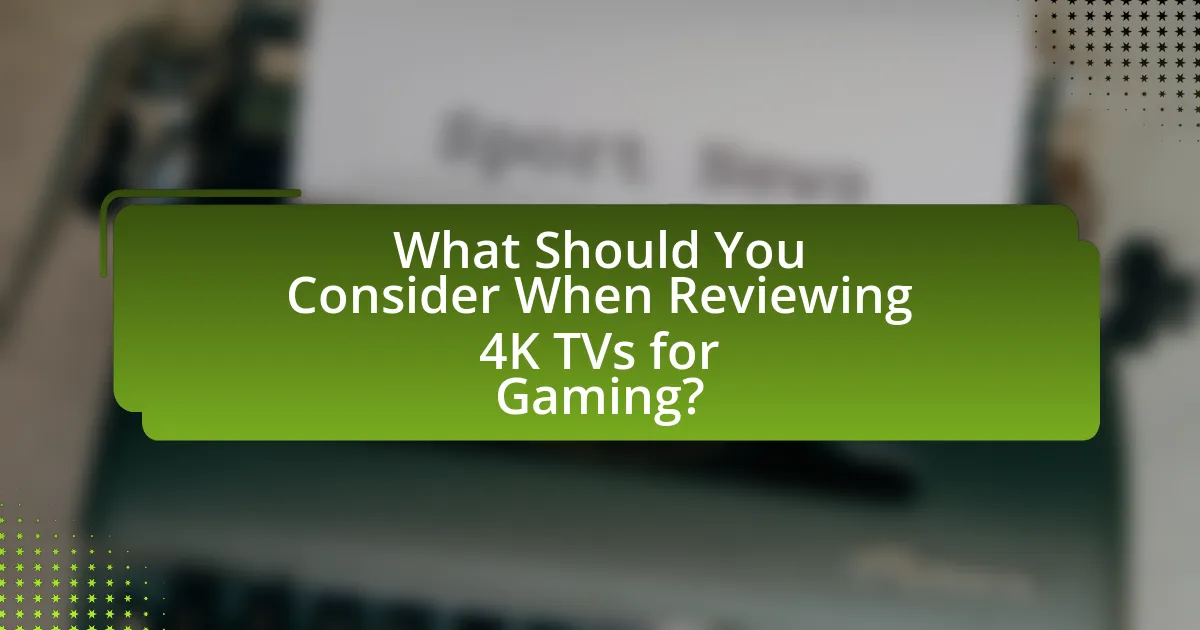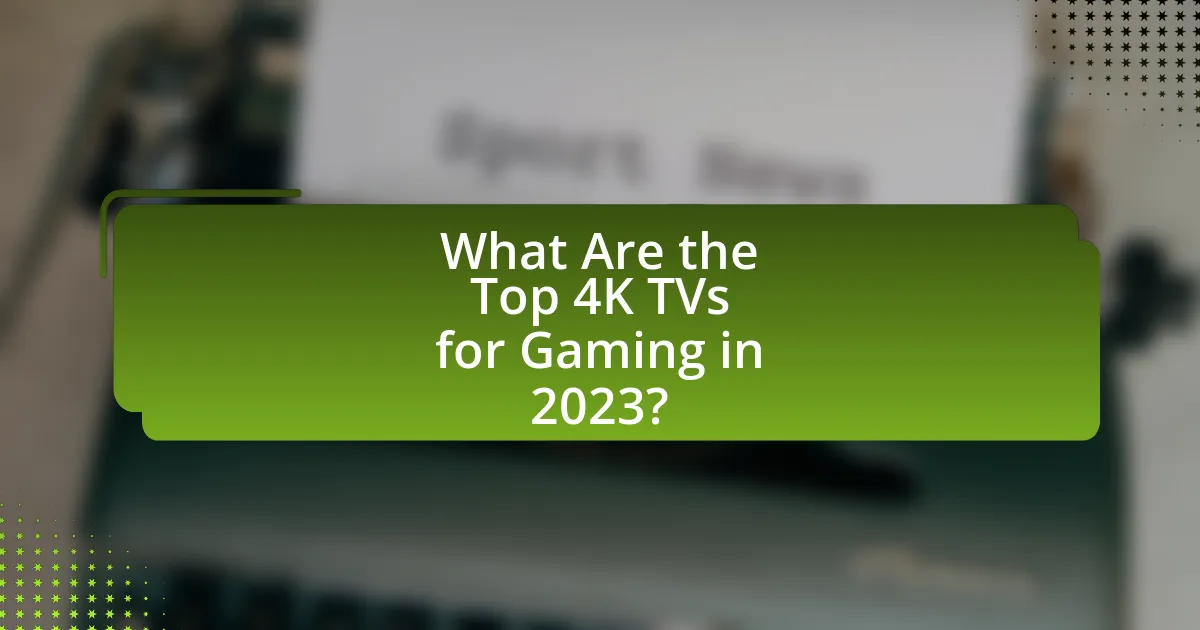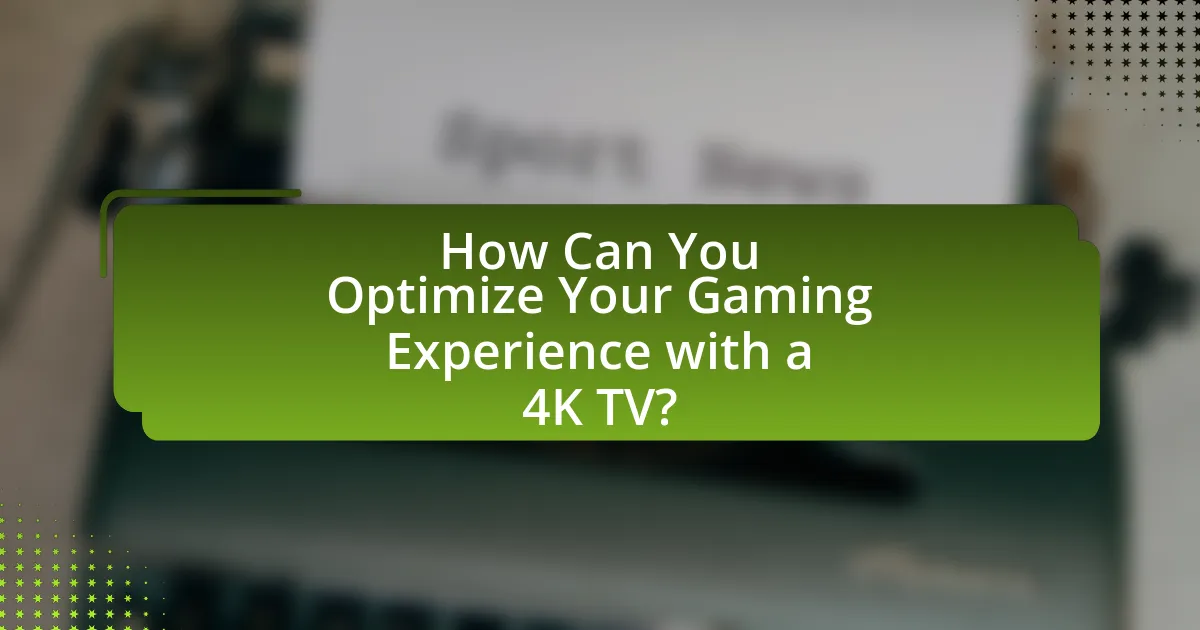The article focuses on reviewing the best 4K TVs for gaming, emphasizing essential features and performance metrics that enhance the gaming experience. Key considerations include input lag, refresh rate, HDR support, and HDMI 2.1 compatibility, which are critical for responsive gameplay and visual clarity. The article also explores the significance of 4K resolution, the impact of refresh rates on gameplay, and the advantages of different TV technologies such as OLED, QLED, and LED-LCD. Additionally, it highlights top models for 2023, leading brands in the market, user reviews, and troubleshooting tips to optimize gaming setups.

What Should You Consider When Reviewing 4K TVs for Gaming?
When reviewing 4K TVs for gaming, consider factors such as input lag, refresh rate, HDR support, and HDMI 2.1 compatibility. Input lag should ideally be below 20 milliseconds for responsive gameplay, while a refresh rate of at least 120Hz enhances motion clarity. High Dynamic Range (HDR) support improves color and contrast, making games visually stunning. HDMI 2.1 is crucial for next-gen consoles, enabling features like 4K at 120Hz and Variable Refresh Rate (VRR). These specifications ensure an optimal gaming experience, as supported by industry benchmarks and expert reviews.
How do resolution and refresh rate impact gaming performance?
Resolution and refresh rate significantly impact gaming performance by affecting visual clarity and fluidity of motion. Higher resolution, such as 4K, provides more pixels, resulting in sharper images and greater detail, which enhances the gaming experience. Conversely, refresh rate, measured in hertz (Hz), indicates how many times per second the display updates the image. A higher refresh rate, like 120Hz, allows for smoother motion and reduces motion blur, which is crucial in fast-paced games. Studies show that gamers often prefer refresh rates above 60Hz for competitive play, as it can lead to improved reaction times and overall performance. Therefore, both resolution and refresh rate are critical factors that determine the quality and responsiveness of gaming visuals.
What is the significance of 4K resolution in gaming?
4K resolution is significant in gaming because it provides a higher pixel density, resulting in sharper and more detailed images. This increased clarity enhances the overall gaming experience, allowing players to see finer details in textures and environments, which can improve immersion and gameplay. Studies show that 4K displays have four times the resolution of 1080p, with 3840 x 2160 pixels compared to 1920 x 1080 pixels, leading to a more visually appealing and engaging experience. Additionally, many modern gaming consoles and PCs are designed to support 4K output, making it a standard for high-end gaming setups.
How does refresh rate affect gameplay experience?
Refresh rate significantly affects gameplay experience by determining how many frames per second a display can show, which directly influences motion clarity and responsiveness. Higher refresh rates, such as 120Hz or 240Hz, provide smoother visuals and reduce motion blur, enhancing the player’s ability to track fast-moving objects and react quickly. Studies indicate that gamers using displays with higher refresh rates report improved performance in competitive scenarios, as the reduced latency allows for more precise control and quicker reactions. For instance, a 2019 study published in the Journal of Gaming and Virtual Worlds found that players using 144Hz monitors performed better in fast-paced games compared to those using 60Hz displays, highlighting the importance of refresh rate in gaming performance.
What features are essential for a gaming TV?
Essential features for a gaming TV include low input lag, high refresh rates, and support for variable refresh rate technologies. Low input lag, ideally below 20 milliseconds, ensures that there is minimal delay between the controller input and the on-screen action, which is crucial for competitive gaming. High refresh rates, such as 120Hz, provide smoother motion and reduce motion blur, enhancing the gaming experience. Additionally, support for variable refresh rate technologies like NVIDIA G-Sync or AMD FreeSync helps eliminate screen tearing and stuttering, resulting in a more fluid gameplay experience. These features are critical for gamers seeking optimal performance and responsiveness in their gaming sessions.
Why is input lag important for gamers?
Input lag is crucial for gamers because it directly affects the responsiveness of gameplay. High input lag can lead to delays between a player’s actions and the corresponding on-screen responses, which can hinder performance in fast-paced games. Studies indicate that input lag above 20 milliseconds can negatively impact competitive gaming, as players may miss critical moments due to delayed feedback. For instance, professional gamers often prefer displays with input lag under 10 milliseconds to ensure optimal reaction times and maintain a competitive edge.
How do HDR and color accuracy enhance gaming visuals?
HDR (High Dynamic Range) and color accuracy significantly enhance gaming visuals by providing a broader range of colors and improved contrast between light and dark areas. HDR allows for brighter highlights and deeper shadows, creating a more realistic and immersive experience. For instance, HDR can display up to 1,000 nits of brightness compared to standard dynamic range displays, which typically max out around 300 nits. This capability enables gamers to see details in bright scenes that would otherwise be washed out.
Color accuracy ensures that the colors displayed on the screen closely match the intended colors of the game developers, which is crucial for visual fidelity. Accurate color reproduction can enhance the emotional impact of a game, as players can experience environments and characters as they were designed to be seen. Research indicates that displays with high color accuracy can reproduce over 90% of the DCI-P3 color space, which is widely used in digital cinema, further emphasizing the importance of color fidelity in gaming.
What are the different types of 4K TVs available for gaming?
The different types of 4K TVs available for gaming include OLED, QLED, and LED-LCD models. OLED TVs, such as those from LG and Sony, offer superior contrast and faster response times, making them ideal for immersive gaming experiences. QLED TVs, primarily from Samsung, provide vibrant colors and high brightness levels, which enhance gameplay in well-lit environments. LED-LCD TVs, while generally more affordable, can still deliver good performance with features like local dimming and high refresh rates, suitable for casual gamers. Each type has distinct advantages that cater to various gaming preferences and setups.
What distinguishes OLED from LED TVs in gaming?
OLED TVs distinguish themselves from LED TVs in gaming primarily through superior contrast ratios and faster response times. OLED technology allows each pixel to emit its own light, resulting in true blacks and vibrant colors, which enhances the gaming experience by providing more depth and detail in dark scenes. In contrast, LED TVs rely on a backlight, which can lead to light bleed and less accurate color representation. Additionally, OLED displays typically have response times as low as 0.1 milliseconds, significantly reducing motion blur during fast-paced gaming, while LED TVs generally have higher response times, often around 5 milliseconds or more. This combination of better contrast and faster response times makes OLED TVs more favorable for gamers seeking immersive visuals and smooth gameplay.
How do QLED TVs compare to other types for gaming purposes?
QLED TVs offer superior brightness and color accuracy for gaming compared to OLED and LED TVs. This is due to their quantum dot technology, which enhances color reproduction and allows for higher peak brightness levels, making them ideal for HDR gaming. Additionally, QLED TVs typically have lower input lag and faster response times, which are crucial for competitive gaming. Studies show that QLED displays can achieve brightness levels exceeding 1000 nits, significantly enhancing visibility in bright environments, while OLEDs may struggle with brightness and can suffer from burn-in issues during prolonged gaming sessions.

What Are the Top 4K TVs for Gaming in 2023?
The top 4K TVs for gaming in 2023 include the LG C2 OLED, Samsung QN90B Neo QLED, Sony A80K OLED, and TCL 6-Series R655. The LG C2 OLED is renowned for its exceptional picture quality and low input lag, making it ideal for gamers. The Samsung QN90B Neo QLED offers impressive brightness and HDR performance, enhancing gaming visuals. The Sony A80K OLED is praised for its color accuracy and motion handling, providing a smooth gaming experience. Lastly, the TCL 6-Series R655 combines affordability with solid performance, featuring Mini-LED technology for better contrast and brightness. These models are recognized for their gaming-friendly features, including HDMI 2.1 support, variable refresh rates, and low latency, making them top choices for gamers in 2023.
Which brands are leading the market for gaming TVs?
The leading brands in the market for gaming TVs are LG, Samsung, and Sony. LG is recognized for its OLED technology, which provides superior contrast and color accuracy, making it ideal for gaming. Samsung is known for its QLED displays that offer high brightness and vibrant colors, enhancing the gaming experience. Sony’s Bravia series features advanced processing technology, delivering smooth motion and low input lag, which is crucial for competitive gaming. These brands consistently receive high ratings and positive reviews from gamers and industry experts alike, confirming their dominance in the gaming TV market.
What are the standout models from each brand?
The standout models from each brand in the context of 4K TVs for gaming include the LG C2 OLED, Samsung QN90B Neo QLED, Sony A80J OLED, and TCL 6-Series R646. The LG C2 OLED is renowned for its exceptional color accuracy and low input lag, making it ideal for gaming. The Samsung QN90B Neo QLED offers impressive brightness and HDR performance, enhancing the gaming experience. The Sony A80J OLED is praised for its excellent motion handling and immersive visuals. Lastly, the TCL 6-Series R646 provides great value with its strong performance and features tailored for gamers. These models have been recognized in various reviews and comparisons for their superior gaming capabilities.
How do these models compare in terms of features and performance?
The models compare significantly in features and performance, with variations in display technology, refresh rates, and input lag. For instance, OLED models typically offer superior contrast and color accuracy, while LED models may provide higher brightness levels. Performance metrics such as response time and refresh rates also differ; high-end models often feature 120Hz refresh rates, which enhance gaming fluidity. Additionally, input lag is crucial for gaming, with top models achieving as low as 5ms, ensuring minimal delay during gameplay. These distinctions are essential for gamers seeking optimal visual experiences and responsiveness.
What are the user reviews saying about these gaming TVs?
User reviews indicate that gaming TVs are praised for their low input lag and high refresh rates, which enhance the gaming experience. Many users highlight features such as HDMI 2.1 support, which allows for 4K gaming at 120Hz, and variable refresh rate technology that reduces screen tearing. Additionally, reviews often mention the importance of picture quality, with OLED models receiving acclaim for their deep blacks and vibrant colors. Users also appreciate smart features and gaming modes that optimize performance. Overall, the consensus is that these TVs significantly improve gameplay, making them a worthwhile investment for gamers.
What common praises and complaints do users have?
Users commonly praise 4K TVs for gaming for their exceptional picture quality, vibrant colors, and high refresh rates, which enhance the gaming experience. Many users highlight features such as low input lag and support for HDR (High Dynamic Range), which contribute to immersive gameplay. Conversely, users often complain about issues like high prices, limited viewing angles, and occasional software bugs that affect performance. These complaints are frequently mentioned in user reviews and forums, indicating a consistent pattern in user experiences with these devices.
How do user experiences reflect on the performance of these TVs?
User experiences significantly reflect on the performance of 4K TVs for gaming by providing insights into real-world usage, responsiveness, and visual quality. For instance, gamers often report on input lag, which affects gameplay; a study by DisplayLag found that TVs with lower input lag (under 20ms) enhance user satisfaction and performance. Additionally, user reviews frequently highlight issues such as motion blur and color accuracy, which directly impact the gaming experience. According to a survey by TechRadar, 78% of gamers prioritize picture quality and responsiveness, indicating that user feedback is crucial for assessing how well these TVs perform in gaming scenarios.
What is the price range for the best gaming 4K TVs?
The price range for the best gaming 4K TVs typically falls between $800 and $3,000. This range reflects various models that offer advanced features such as low input lag, high refresh rates, and support for HDMI 2.1, which are essential for an optimal gaming experience. For instance, popular models from brands like LG, Samsung, and Sony often start around $800 for entry-level options and can exceed $3,000 for high-end models with superior display technology and additional gaming features.
How does price correlate with features and performance?
Price directly correlates with features and performance in 4K TVs for gaming, as higher-priced models typically offer advanced technologies and superior specifications. For instance, premium 4K TVs often include features such as higher refresh rates, better HDR support, and enhanced color accuracy, which significantly improve gaming experiences. A study by DisplayMate Technologies found that top-tier TVs can have up to 30% better color accuracy and brightness compared to budget models, demonstrating that investment in higher-priced options yields tangible performance benefits.
What budget options are available without sacrificing quality?
Budget options for 4K TVs that maintain quality include models from brands like TCL, Hisense, and Vizio, which offer competitive features at lower price points. For instance, the TCL 6-Series provides excellent picture quality with Mini-LED technology and supports HDR formats, making it a strong choice for gaming without a high price tag. Similarly, the Hisense U8G offers impressive brightness and color accuracy, along with low input lag, ideal for gamers. Vizio’s M-Series also delivers solid performance with good contrast and gaming features, all while being budget-friendly. These options demonstrate that it is possible to find high-quality 4K TVs for gaming without exceeding budget constraints.

How Can You Optimize Your Gaming Experience with a 4K TV?
To optimize your gaming experience with a 4K TV, ensure that you use a model with low input lag and high refresh rates, ideally 120Hz or higher. Low input lag, typically below 20 milliseconds, allows for more responsive gameplay, while high refresh rates provide smoother motion, reducing blurriness during fast-paced action. Additionally, enable features like Game Mode, which minimizes processing time, and ensure your HDMI cables support HDMI 2.1 for optimal performance. Research indicates that TVs with these specifications significantly enhance the gaming experience by providing clearer visuals and more responsive controls, making them ideal for competitive gaming.
What settings should you adjust for the best gaming performance?
To achieve the best gaming performance, adjust the graphics settings, resolution, refresh rate, and input lag settings on your 4K TV. Lowering graphics settings such as texture quality and shadow detail can significantly improve frame rates, while setting the resolution to match the native resolution of the TV ensures optimal clarity. Increasing the refresh rate to the maximum supported by the TV reduces motion blur and enhances responsiveness. Additionally, enabling game mode minimizes input lag, providing a more immediate response to player actions. These adjustments collectively enhance the gaming experience by ensuring smoother visuals and quicker reactions.
How do picture settings affect gameplay?
Picture settings significantly affect gameplay by influencing visual clarity, color accuracy, and response time. Adjustments such as brightness, contrast, and sharpness can enhance the visibility of details in dark or bright scenes, which is crucial for competitive gaming. For instance, a higher contrast setting can make enemies more distinguishable against backgrounds, improving reaction times. Additionally, settings like input lag can impact how quickly a player’s actions are reflected on-screen; lower input lag settings lead to more responsive gameplay. Research indicates that optimal picture settings can enhance immersion and performance, as players can better perceive their environment and react accordingly.
What audio settings enhance the gaming experience?
Audio settings that enhance the gaming experience include enabling surround sound, adjusting equalizer settings, and utilizing spatial audio features. Surround sound creates an immersive environment by allowing players to hear sounds from multiple directions, which is crucial for situational awareness in games. Adjusting equalizer settings can optimize audio frequencies to match personal preferences and game genres, enhancing clarity and impact. Spatial audio features, such as Dolby Atmos, provide a three-dimensional sound experience, making it easier for players to pinpoint the location of in-game sounds. These settings collectively improve the overall audio experience, leading to a more engaging and realistic gaming environment.
What accessories can improve your gaming setup with a 4K TV?
To improve your gaming setup with a 4K TV, consider using a high-quality HDMI 2.1 cable, a gaming headset with surround sound, and a gaming chair designed for comfort and support. HDMI 2.1 cables support higher bandwidth, enabling features like 120Hz refresh rates and variable refresh rate (VRR), which enhance gaming performance. A gaming headset with surround sound provides an immersive audio experience, allowing players to hear in-game sounds more accurately. Additionally, a gaming chair designed for ergonomics can enhance comfort during long gaming sessions, reducing fatigue and improving overall gameplay experience.
Which gaming consoles are best suited for 4K TVs?
The gaming consoles best suited for 4K TVs are the PlayStation 5 and Xbox Series X. Both consoles support native 4K gaming, offering enhanced graphics and performance that take full advantage of 4K resolution. The PlayStation 5 features a custom SSD that significantly reduces load times, while the Xbox Series X boasts powerful hardware capable of delivering 4K gaming at up to 120 frames per second. These specifications ensure an optimal gaming experience on 4K TVs, making them the top choices for gamers seeking high-definition visuals.
How can sound systems enhance the overall experience?
Sound systems enhance the overall experience by providing immersive audio that complements visual content, particularly in gaming. High-quality sound systems deliver clear dialogue, dynamic sound effects, and rich music, which can significantly increase engagement and emotional impact during gameplay. For instance, studies show that players using surround sound systems report a heightened sense of presence and realism, leading to improved performance and enjoyment. Additionally, sound systems can help players detect in-game audio cues, such as footsteps or environmental sounds, which are crucial for strategic gameplay.
What are some common troubleshooting tips for gaming on a 4K TV?
To troubleshoot gaming issues on a 4K TV, first ensure that the HDMI cable supports 4K resolution and is securely connected. Many TVs require HDMI 2.0 or higher for optimal 4K performance. Next, check the TV settings to confirm that the correct input source is selected and that the TV is set to game mode, which reduces input lag. Additionally, verify that the console or PC is configured to output 4K resolution in its display settings. If experiencing screen flickering or artifacts, consider adjusting the TV’s refresh rate or resolution settings. Lastly, ensure that the TV’s firmware is up to date, as manufacturers often release updates to improve performance and compatibility with gaming devices.
How can you resolve input lag issues?
To resolve input lag issues, adjust the settings on your 4K TV to enable game mode, which minimizes processing time. Game mode reduces the input delay by bypassing certain image enhancements that can slow down response times. Additionally, using a wired connection instead of Wi-Fi can further decrease lag, as wired connections typically offer more stable and faster data transmission. According to a study by DisplayMate Technologies, enabling game mode can reduce input lag by up to 50%, significantly improving gaming performance.
What steps can you take if the picture quality is subpar?
To improve subpar picture quality on a 4K TV, first adjust the picture settings, including brightness, contrast, and sharpness, to optimize the display. Many TVs come with preset modes like “Game” or “Cinema,” which can enhance visual performance for specific content. Additionally, ensure that the TV firmware is updated, as manufacturers often release updates that improve picture quality and performance. Using high-quality HDMI cables and ensuring the source device outputs at the highest resolution can also significantly enhance picture clarity. According to a study by the Consumer Technology Association, proper calibration can improve perceived picture quality by up to 30%.



